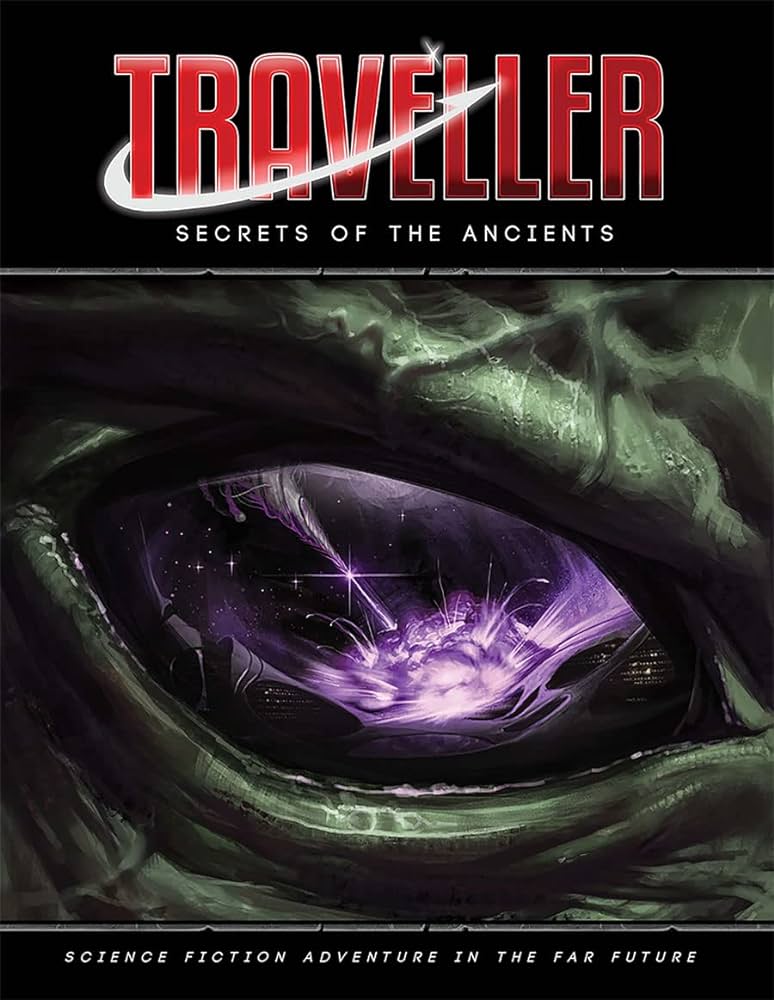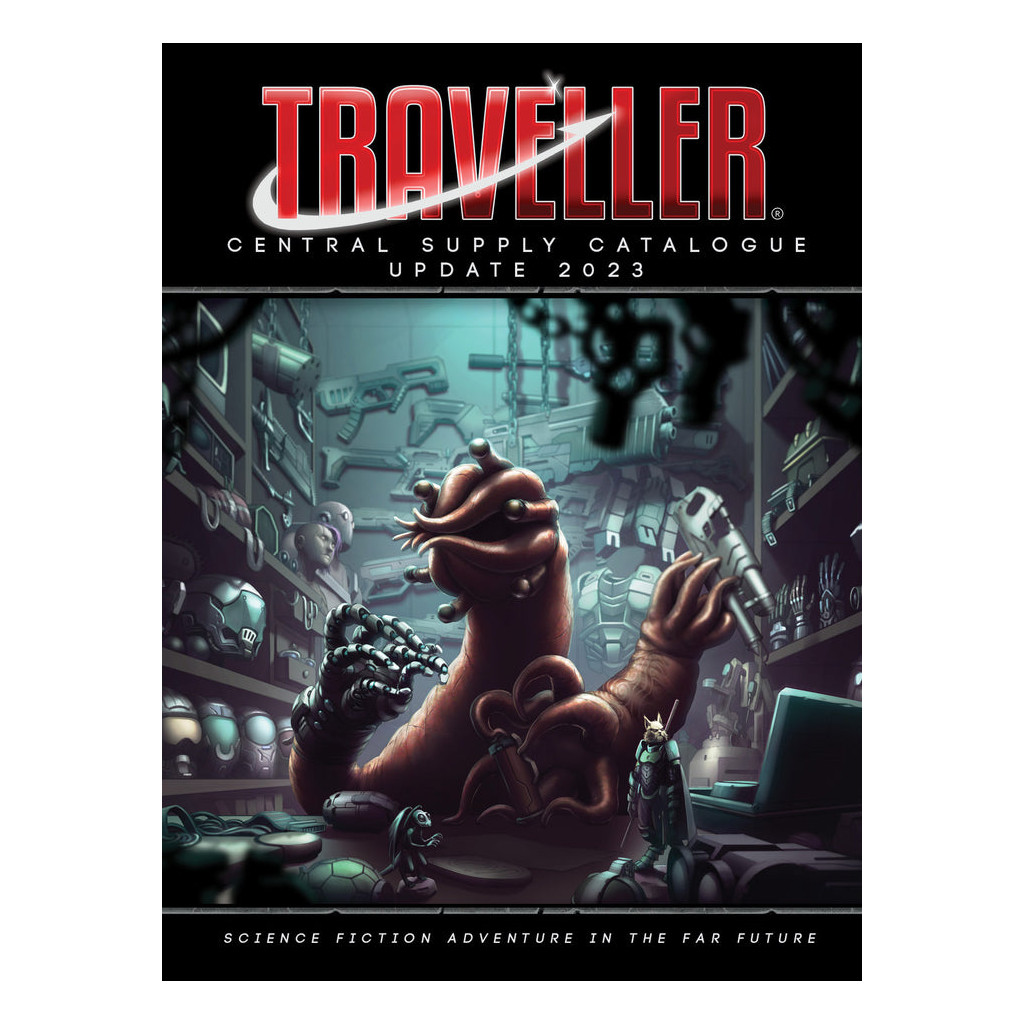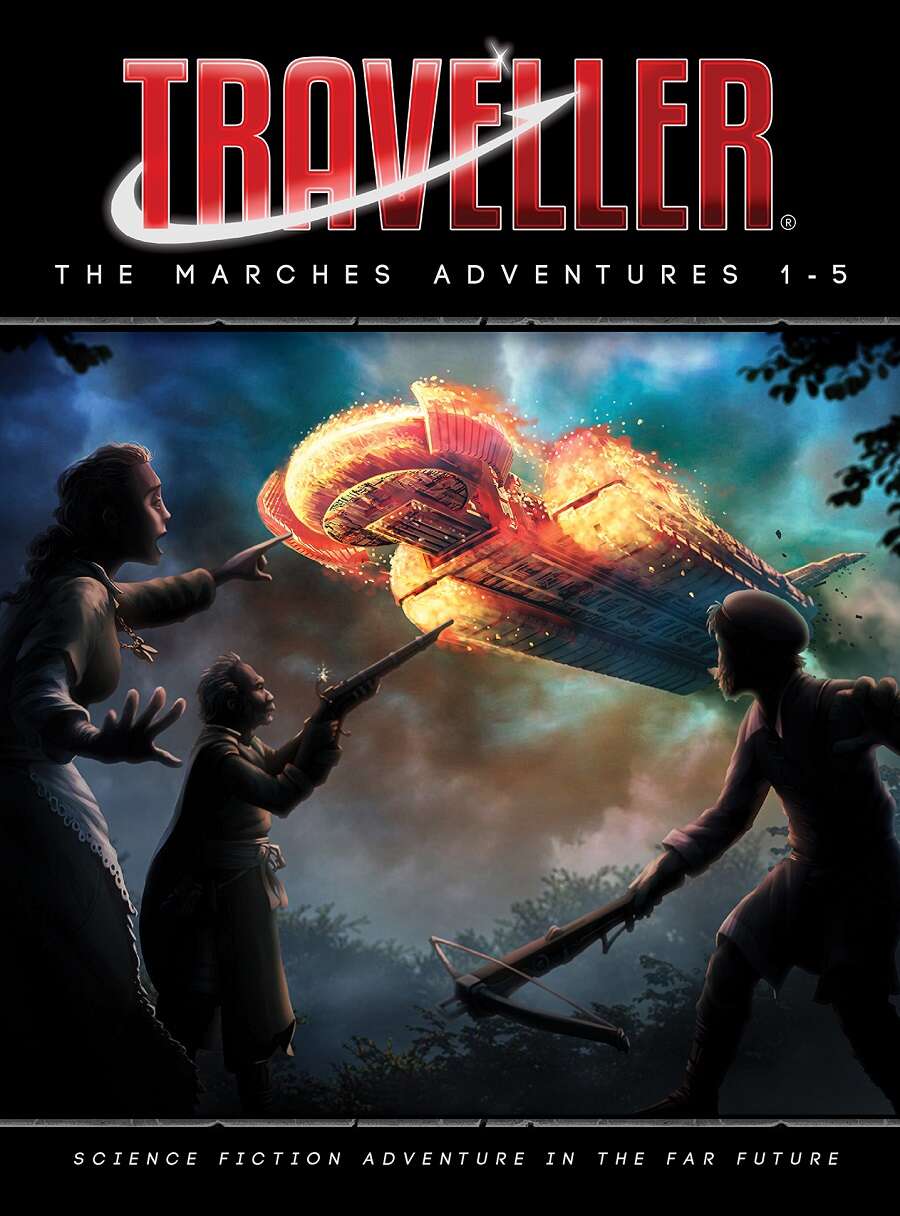The thing about starting a new game-system is knowing how to flesh it out. There is usually 1-2 established pathways, that longterm players will suggest to familiarize newcomers, but what then? If you’re playing D&D 5E, you’re told to get the starter set and Lost Mines of Phandelver, Call of Cthulhu has a starter set, and also the classic “The Haunting”. Traveller has a number of established classic adventures, and the latest Mongoose Edition (2E) did indeed have a starter set (it’s no longer available). However, for starting players it is recommended to use Seth Skorkowsky’s “Death Station” (free to download on Drive Thru RPG) or High and Dry, also known as Marches Adventures #1. However, after you run these, what next?
Traveller is a huge game, and what I love about it is the size and scope. It is a game that can be easy to start, and as complex as you want it to be with rules and systems that can be added and subtracted as needed. Want to build your own ship that caters to the specific needs of the crew and missions you’re hoping to go on? That’s possible. Do you want space combat between multiple ships? Or maybe you don’t. Maybe you just want to dip onto a planet here and there for an adventure and that’s possible to, but to make that work, the material needs to be there (OK, yeah you could homebrew it, but I’m just not the type). That’s where the Marches Adventures 1-5 and later Secret of the Ancients comes in perfectly.
Why the focus on these modules/books? Well Traveller in a way is built around interstellar location mapping (Check out TravellerMap.com for examples, if you haven’t already read the core rulebook, or played the game). Both the Marches Adventure 1-5 and Secret of the Ancients take place in the Spinward Marches sector of the universe. Because players will be literally travelling between destinations (unless the referee decides to just handwave them into each location at the start of each adventure), it is beneficial for Traveller Referee to keep their campaigns in one sector. A benefit to this is being able to play Traveller as intended. In between adventures while on the ship Travellers can work on their skills so they can level them up after enough time, they can operate the ship using those skills and so-on.
But I digress.
Marches Adventures 1-5 contains 5 adventures in the Spinward Marches, a frontier-like Sector in Traveller’s “Third Imperium” setting. The book contains “High and Dry” and “Mission to Mithril” which were previously published in paperback and PDF form, and are still accessible as such. It also contains 3 follow up adventures “Search and Rescue”, “Artemis Wept”, and “Safari World” which appear to have been unpublished before this compendium. They each vary in style, and should give players and referees a good sampling of what Traveller is (or if they are long-time players a good deal of material to play with). I would, suggest playing them in order if you are integrating them into a starter campaign as High and Dry involves the Travellers getting a ship of their own from the Scout Service as a reward for successfully completing the adventure (this is not so much a spoiler as it is offered early on).
In High and Dry the Travellers are sent to a rural planet “Walston” to retrieve a ship for the Scout Service, the problem? It was ditched by the prior crew in the middle of a volcano. This adventure is a really interesting one, because it shows off many of the strengths of Traveller as a game, and while it might not be the most exciting of adventures, it shows off the exploratory nature of the system. Most of the adventure involves hiking up the volcano, and how it affects the Travellers at various altitudes as they scale the mountain. Of course, you can’t show a gun in the first act without firing it in the third, and with a volcano in play, of course an eruption is bound to happen, and does with the Travellers having to deal with the consequences of it, and at the same time test out their new ship.
The follow up to this is Mission to Mithril an frozen take on Dune (no spoilers here the cover image has a snow worm). The Traveller’s end up on the planet of Mithril, a snow covered planet that has a minimal starport. Upon arriving they find the starport in disarray and a distress signal in the distance that takes them on a trek across the snowy tundra. Mission to Mithril is a fantastic follow-up to High and Dry, it incorporates more action, a giant alien monster, and the potential for investigation. It also has a heavy survival element as the Traveller’s are forced to deal with surviving in the brutal frozen landscape for a great deal of time.
Search and Rescue is interesting, it doesn’t really play entirely as something that is an immediate follow up to the Mithril adventure without some work on the part of the referree. In it the Traveller’s are in the Gorram system, their ship the “High n Dry” is on the sidelines here, and they are in a Red Zone with a contract to run a literal search and rescue operation. The thing about this particular module is that it can be played as a straight-forward one shot (the actual adventure contained in it is exceptionally short and simple) or it can be used as a framework for a referred to tie in other adventures.
The Traveller’s are contracted and running out of a rescue vessel, in what amounts to red-zoned territory. Before running the main adventure it would be quite easy to have them do contractual work, have them get to know the NPC’s, and then run it in due time. The actual adventure involves a crash into a planet of NPC’s they should have been made aware of, a rescue mission, some cool action (though some of the villain could be a bit harder to take out), and elements of intrigue.
The final two modules in the book are what I’ll label as safari adventures. The first is Artemis Wept, which sees the Traveller’s working as part of Project Artemis where they will escort an endangered species to a backwater world in the hopes they can repopulate it. However, nature is chaos and has a way of interfering in the best laid plans and the Travellers will face an ethical conundrum during the course of the adventure. The adventure comes in 3 parts with the first having the Travellers interacting with elites and finding out about their mission with the second two parts involving the protection of the species. The adventure is a lot of fun, and involves heavy roleplay elements especially early on.
The final adventure Safari World sees the Travellers again involved in the natural world. In this case escorting a wealthy patron to a world to discover an undocumented species that he wishes to recover so he can have naming rights over it. This is a great exploratory adventure as the Travellers play escort on a bizarre safari planet. The main action that drives this is the deadline to return to Mertactor at the conclusion of the module in order to make the deadline.

The five modules from the book offer a lot of different views into the world of Traveller, and really showcase what the RPG itself can do to new players and referree’s. The one thing it really didn’t was space combat, but that isn’t something that’s going to be used all the time anyway. Between modules Travellers will get the chance to train, level up, do all the work on their ship that is required of normal game play. In short this is a great introductory book into the world of Traveller, so the question remains where to go from here?
And my answer would be Secrets of the Ancients.
You’ve run through the Marches Adventures, you are now used to your characters, and are comfortable in your flow. You don’t want to start over, and if you’re like me, you don’t write much for your games, well this is THEE Mongoose Traveller 2E campaign to take place in the Spinward Marches, so you can easily just pop it in after Safari Worlds (or whatever you choose to be running), and take it from there.
Secrets of the Ancients takes place over 10 chapters and begins with one of the Traveller’s Uncle Vlen Beckett dying under mysterious circumstances. The Travellers must go to Regina to retrieve his body, and return it home, but right away things appear to be out of the ordinary, and this is before they end up on Uncle Vlen’s home planet and in the midst of whatever familial issues Vlen left behind. However, before they can even get settled they find themselves being chased down by the law, and it gets even more bizarre from there before delving into the esoteric.
Secrets of the Ancients is spun-off of the 1980’s original Traveller adventure which I have a passing familiarity with. It was originally redone by Mongoose in 2011, and revised and expanded now. It also appears to be part of a trilogy coming foreword in 2023 with Wrath and Mysteries of the Ancients, but those I have not read. This particular campaign has a lot of investigation, action, and plot twists. At times PC’s might feel railroaded, so it is up to the referee to work out some of those issues, though it is the nature of this campaign, which has a very space opera cinematic style. The 10 chapters will take roughly 2-4 sessions each so between these 2 books you could have between a year to 2 years of gaming.

Finally, we get to Central Supply Catalogue Update 2023. With a game as dynamic and HUGE as Traveller it’s seriously important to make sure your players have access to everything they need. In my current Cyberpunk Red game I have the Black Chrome book alreadys ready at the table, and in the future when Traveller is back at the table the Central Supply Catalogue will be one of the most necessary books among my players outside of the core rule book itself.
The basics of the Central Supply Catalogue is basically stuff for your Traveller to buy for their adventures. The CSC breaks this down into categories like armour, weaponry, electronics, home comfort, and so forth. If this was its only function it would be a highly recommended book on that alone. However, it includes new rules, these include equipment availability rules, rules that pertain to the legality of items on specific types of planets, rules for fabricating items and more. Beyond that we get additional rules for such things as armor, and various types of weapons.
I would basically say if you are a new referee, getting the core rulebook, and these 3 books would have you 100% set for a while. If you wanted to really make sure you’re set I would add the new High Guard update. Needless to say everything in this review is HIGHLY RECOMMMENDED!

